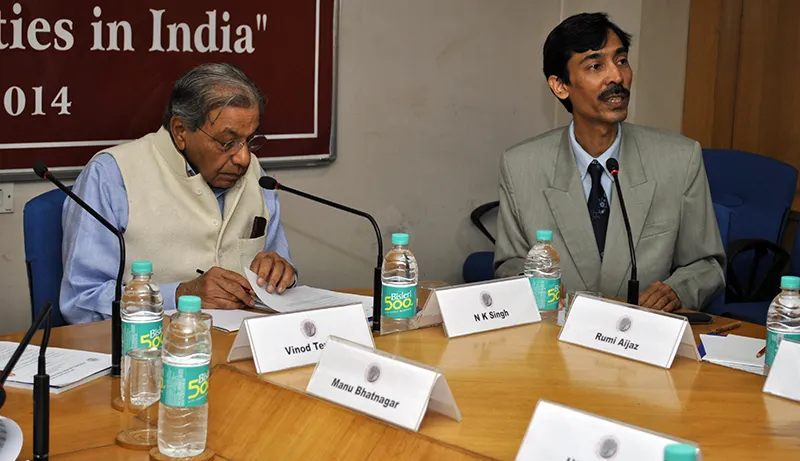-
CENTRES
Progammes & Centres
Location
Most participants at an ORF conference on urban development and creation of 100 smart cities in India felt that creation of smart cities is an extremely challenging exercise and for this, careful planning and effective project implementation are required.

The new Indian government has announced a series of development measures for the betterment of the nation and the people. One ambitious programme is to build 100 smart cities at various locations in the country. It is thought that creation of smart cities would be useful in the context of various social and economic challenges confronting the nation. There is belief that India would do better if urban growth is managed efficiently or smartly. Presently, the government is engaged in developing a road map to achieve this vision.
In this respect, Observer Research Foundation organised a half-day seminar on September 23, 2014 at its Delhi campus to understand what the research community is thinking on this subject and to discuss the principles to be followed in creation of smart cities. Following are the key ideas that emerged from the deliberations.
Most participants consider creation of smart cities as an extremely challenging exercise for which careful urban planning and effective project implementation would be needed. Some hold the view that instead of creating new smart cities, focus should be laid on improving living conditions in existing cities.
In his opening remarks, Prof. Vinod Tewari, former Director of National Institute of Urban Affairs, discussed the JNNURM experience and commented that the real issues underlying urban development are yet to be addressed. The chair informed that funds utilisation and project implementation under JNNURM has been less due to capacity constraints. In his opinion, certain conditions are to be met in order to call places as sustainable or smart. With respect to existing cities, it was mentioned that planning and management capacity of municipal functionaries for city development must be enhanced by increasing the number of training institutions in the country.
Mr. N.K. Singh, honorary advisor to ORF and former Member of Parliament, gave the keynote address. He said that JNNURM should be credited for enhancing the awareness and consciousness with regard to the problems of urbanisation, which so far has been neglected. Further, the idea of creating smart cities was supported in view of a dire need for having alternative occupational activities other than agriculture.
He, however, cautioned against excessive privatisation. To this end, he enquired "how much and in what manner can PPP be an important vehicle which garners resources, harnesses managerial talent, employs cutting edge technologies, but are able to assign rates of return which are commensurate and is not flogging of public assets in a manner which has greater public acceptability".
The keynote address was followed by four presentations. The first was given by Mr. Manu Bhatnagar, Principal Director, Natural Heritage Division, INTACH, who suggested that new urban development should be based on lessons learnt from the new development that has already been carried out. Some previous initiatives (such DLF City Gurgaon, Lavasa, Mahindra World City Jaipur), he said, have benefited the affluent people, and are not in line with the compact city concept.
According to him, the success of new cities depends on the proximity to existing mother cities which would provide the necessary sustenance. Also, it was pointed out that in new city development, the natural resource base and economic base must be considered for holistic sustainability, and city plans should be implemented swiftly and not sluggishly.
Mr. Utpal Deka, MD, Cambridge Systematics Consulting and Technology Pvt. Ltd, in his presentation focused on the need to have smart mobility in existing cities. His analysis showed that when compared with world cities, Indian cities are much below average in the mobility index which is an unhealthy sign. He urged for paying immediate attention to existing problems, such as high motorisation rate, less infrastructure for pedestrians, less public transport facilities, neglect in urban freight management, lack of understanding and knowledge about people’s requirement, lack of data for planning purposes, etc. The importance of planning for a transport network as against a corridor, integration of multiple agencies, and capacity building at various levels was also highlighted.
Ms. Chidambara, Assistant Professor in the Department of Urban Planning at the School of Planning and Architecture, described numerous challenges that would be encountered in the creation of smart cities. She said that by simply copying solutions from developed cities around the world would lead us to nowhere, and the need of the hour is to devise innovative plans that would work in India. In her opinion, a smart city should be able to: attract investment, business and people; cater to a diverse range and scale of economic activities and not just foreign investors or businesses; support local and small entrepreneurs in starting a business; provide continuous supply of energy from renewable sources; and offer a better mobility system to the commuters especially at the neighbourhood level.
The final presentation was given by Dr. Srikanta K. Panigrahi, Director General, Carbon Minus India. He agreed with the previous speaker regarding the preparation of innovative plans, and re-emphasised that smart cities in India must be designed keeping in view our values and requirements and foreign models should not be replicated. It was pointed out that to live up to their name, smart cities should offer an environment wherein people of various ages and sections of the society should get everything that is needed to live a good life.
(This report is prepared by Dr. Rumi Aijaz, Senior Fellow, Observer Research Foundation, Delhi)
The views expressed above belong to the author(s). ORF research and analyses now available on Telegram! Click here to access our curated content — blogs, longforms and interviews.